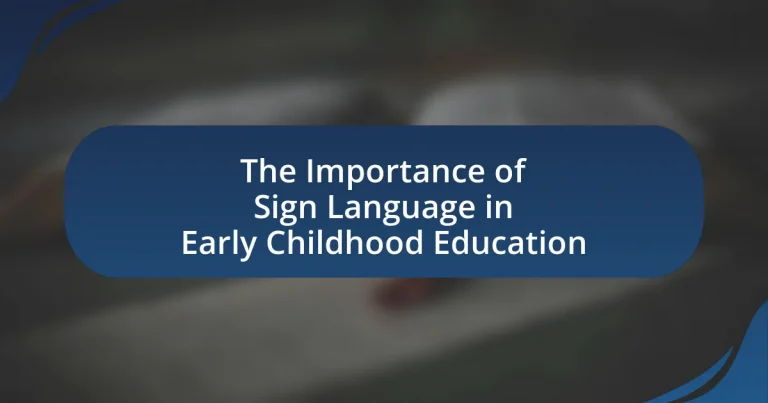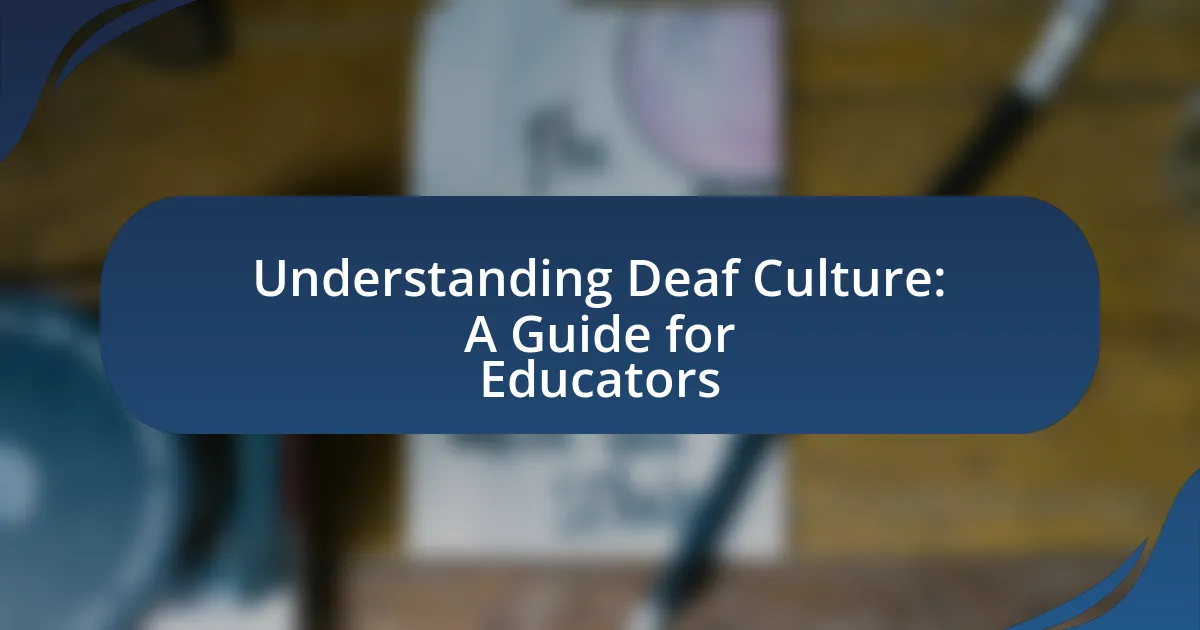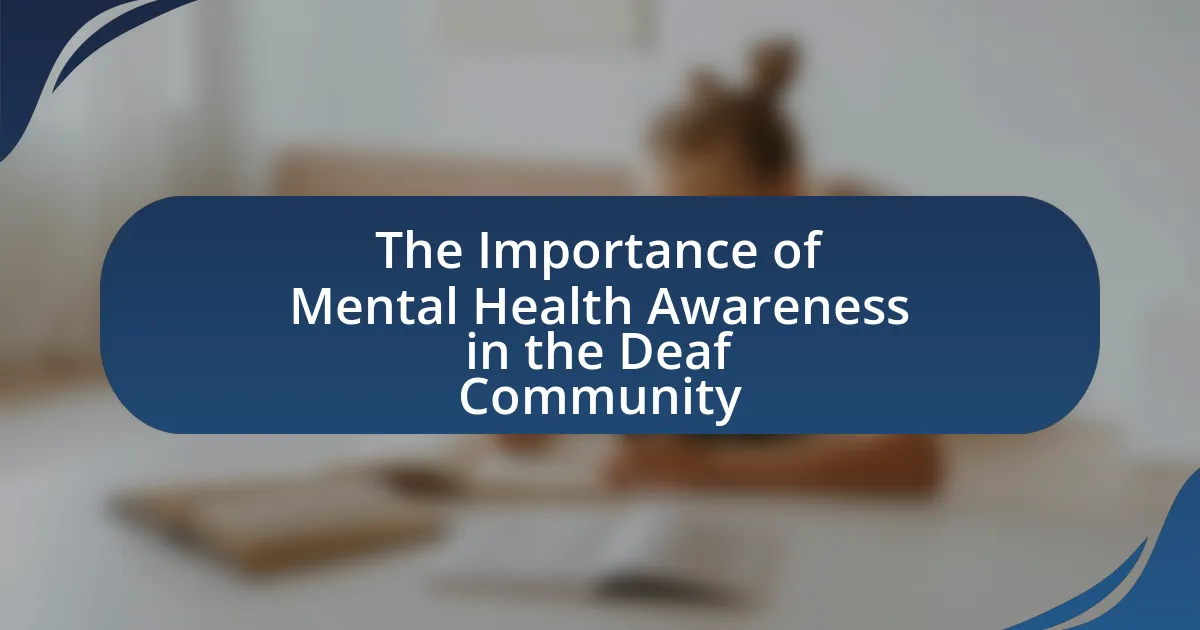Sign language is a vital component of early childhood education, significantly enhancing communication skills and cognitive development in young children. Research shows that incorporating sign language improves language acquisition, vocabulary, and literacy skills, while fostering inclusivity for children with hearing impairments. The article explores the role of sign language in communication and cognitive development, its benefits for social-emotional growth, and effective strategies for educators to implement sign language in the classroom. Additionally, it addresses the challenges educators may face and the long-term impacts of early exposure to sign language on academic success and lifelong learning.
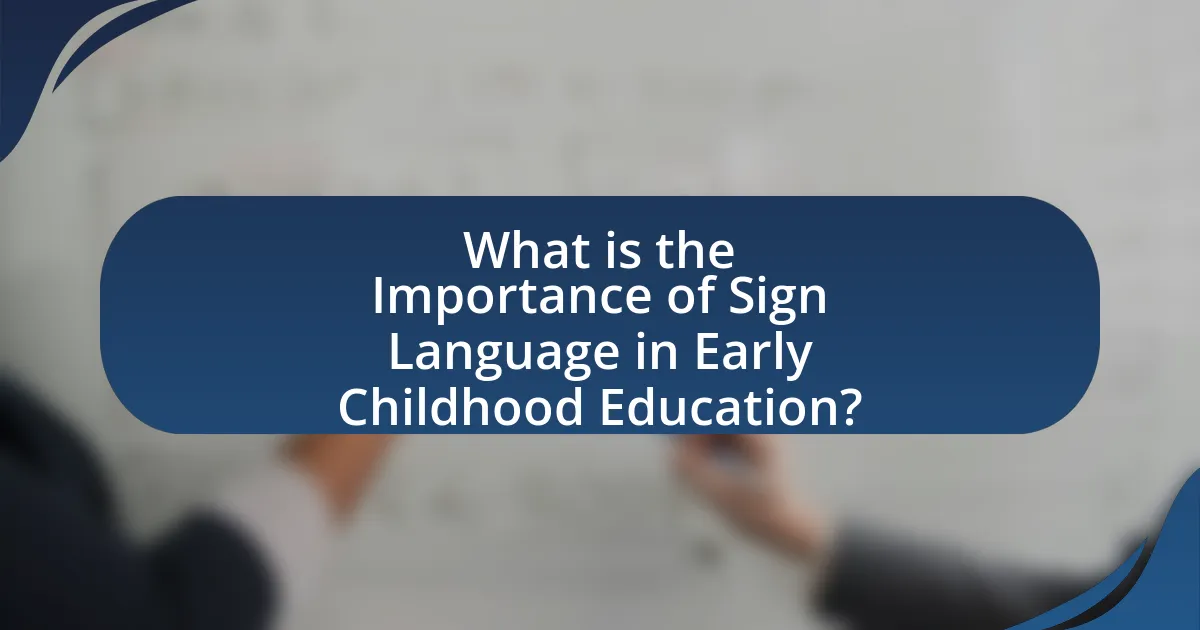
What is the Importance of Sign Language in Early Childhood Education?
Sign language is crucial in early childhood education as it enhances communication skills and cognitive development in young children. Research indicates that incorporating sign language can improve language acquisition, as it provides visual cues that support understanding and retention of spoken language. A study by the National Institute on Deafness and Other Communication Disorders found that children who learn sign language alongside spoken language demonstrate better vocabulary and literacy skills. Additionally, sign language fosters inclusivity, allowing children with hearing impairments to engage fully in educational settings, promoting social interaction and emotional development among all students.
Why is sign language considered essential in early childhood education?
Sign language is considered essential in early childhood education because it enhances communication skills and supports cognitive development in young children. Research indicates that incorporating sign language can improve language acquisition, as it provides visual cues that aid in understanding and retention. A study published in the Journal of Deaf Studies and Deaf Education found that children who learned sign language alongside spoken language demonstrated better vocabulary and literacy skills compared to those who did not. This dual-language approach fosters inclusivity, allowing children with hearing impairments to engage fully in the learning environment, thereby promoting social interaction and emotional development.
What role does sign language play in communication development for young children?
Sign language plays a crucial role in communication development for young children by providing an accessible means of expression that enhances their ability to convey thoughts and emotions. Research indicates that children who learn sign language often experience improved vocabulary and language skills, as it allows them to communicate before they can articulate spoken words. A study published in the Journal of Deaf Studies and Deaf Education found that early exposure to sign language can lead to better cognitive development and social interaction skills in children, as it fosters a sense of inclusion and reduces frustration associated with communication barriers.
How does sign language support cognitive development in early learners?
Sign language supports cognitive development in early learners by enhancing their communication skills and promoting language acquisition. Research indicates that children who are exposed to sign language often demonstrate improved vocabulary and better understanding of abstract concepts compared to their peers who rely solely on spoken language. A study published in the journal “Child Development” by researchers at the University of California found that infants who learned sign language showed advanced cognitive skills, such as problem-solving and memory retention, at an earlier age. This early exposure to a visual language fosters neural connections that are crucial for overall cognitive growth.
What are the key benefits of incorporating sign language in early childhood education?
Incorporating sign language in early childhood education enhances communication skills, cognitive development, and social interaction among children. Research indicates that children who learn sign language can express themselves earlier than their peers, leading to improved language skills and reduced frustration. A study published in the Journal of Deaf Studies and Deaf Education found that children exposed to sign language demonstrated better vocabulary acquisition and understanding of complex concepts compared to those who were not. Additionally, sign language fosters inclusivity, allowing children with hearing impairments to engage fully in classroom activities, promoting a sense of belonging and community.
How does sign language enhance language acquisition in children?
Sign language enhances language acquisition in children by providing a visual and gestural means of communication that supports cognitive development. Research indicates that children who are exposed to sign language often demonstrate improved vocabulary, better understanding of language structure, and enhanced social skills. For instance, a study published in the journal “Child Development” by researchers at the University of California found that children who learned sign language alongside spoken language showed greater linguistic abilities compared to those who only learned spoken language. This dual exposure facilitates early literacy skills and encourages expressive communication, making it a valuable tool in early childhood education.
What impact does sign language have on social-emotional development?
Sign language positively impacts social-emotional development by enhancing communication skills and fostering social interactions. Children who learn sign language often experience improved emotional expression and understanding, which contributes to stronger relationships with peers and caregivers. Research indicates that early exposure to sign language can lead to increased self-esteem and reduced frustration in children, as they can express their needs and feelings more effectively. A study by McKee and McKee (2018) found that children who use sign language demonstrate better emotional regulation and social skills compared to their non-signing peers, highlighting the significant role of sign language in promoting healthy social-emotional growth.
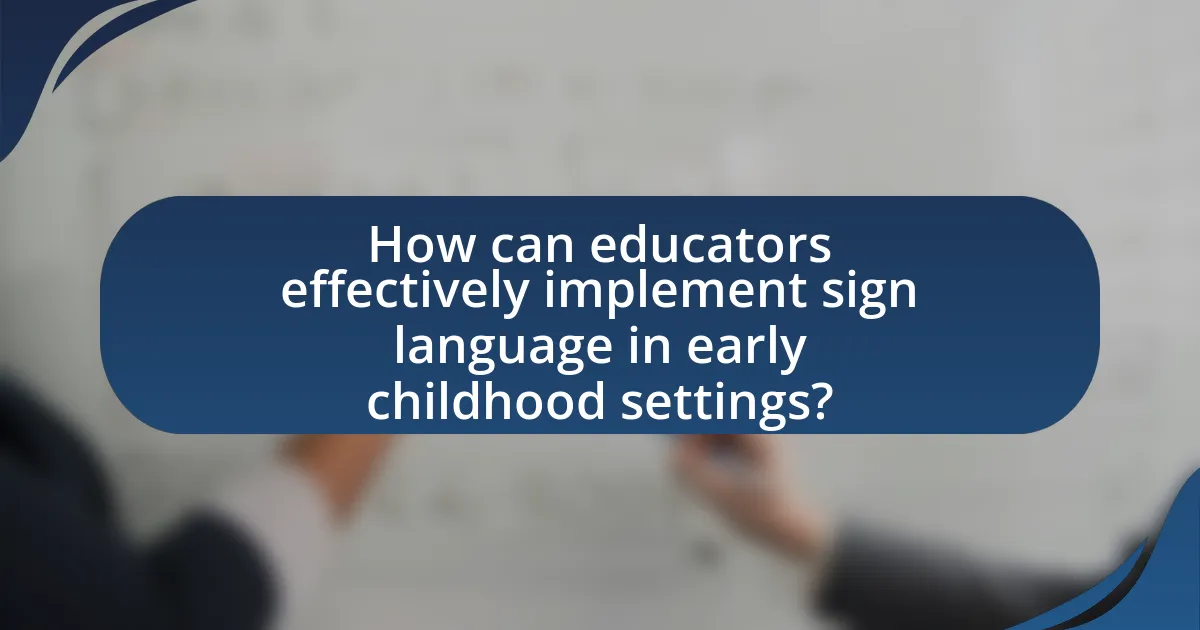
How can educators effectively implement sign language in early childhood settings?
Educators can effectively implement sign language in early childhood settings by integrating it into daily routines and activities. This can be achieved through consistent use of signs during interactions, storytelling, and play, which helps children associate signs with meanings. Research indicates that early exposure to sign language enhances communication skills and cognitive development in young children, as evidenced by a study published in the Journal of Deaf Studies and Deaf Education, which found that children who learned sign language showed improved language acquisition and social skills. Additionally, providing training for educators on sign language and creating a supportive environment encourages both educators and children to use sign language regularly, fostering an inclusive atmosphere that benefits all learners.
What strategies can teachers use to introduce sign language to young children?
Teachers can introduce sign language to young children by using visual aids, interactive games, and consistent reinforcement. Visual aids, such as flashcards and illustrated books, help children associate signs with meanings, enhancing their understanding. Interactive games, like charades or matching activities, engage children in a fun way, promoting active participation and retention of signs. Consistent reinforcement through daily practice and integration into routines solidifies learning, as studies show that repetition aids memory retention in early childhood education. These strategies create an engaging learning environment that fosters communication skills among young learners.
How can visual aids and resources support sign language learning?
Visual aids and resources significantly enhance sign language learning by providing visual context and reinforcing comprehension. These tools, such as images, videos, and interactive applications, help learners associate signs with their meanings, facilitating better retention and recall. Research indicates that visual learning strategies improve language acquisition; for instance, a study published in the Journal of Deaf Studies and Deaf Education found that children who used visual aids demonstrated higher proficiency in sign language compared to those who did not. This evidence underscores the effectiveness of visual resources in supporting the learning process for sign language.
What role do parents play in reinforcing sign language at home?
Parents play a crucial role in reinforcing sign language at home by consistently using it in daily interactions. This regular exposure helps children develop their sign language skills, enhancing communication and fostering a deeper understanding of language concepts. Research indicates that children who are exposed to sign language from an early age show improved cognitive and social skills, as they learn to express themselves effectively. For instance, a study published in the Journal of Deaf Studies and Deaf Education found that early sign language exposure significantly benefits language acquisition and literacy development in deaf and hard-of-hearing children. Thus, parents’ active participation in using sign language at home is essential for their child’s linguistic and social growth.
What challenges might educators face when teaching sign language?
Educators may face several challenges when teaching sign language, including a lack of resources and training. Many educators are not adequately trained in sign language, which can hinder effective teaching and communication. Additionally, there may be limited access to instructional materials and support systems that facilitate sign language education. Research indicates that only 30% of teachers feel confident in their ability to teach sign language, highlighting the need for improved training programs. Furthermore, educators may encounter resistance from parents or institutions unfamiliar with the benefits of sign language, complicating the implementation of effective teaching strategies.
How can educators overcome resistance to learning sign language?
Educators can overcome resistance to learning sign language by implementing engaging, interactive teaching methods that highlight its benefits. Research shows that incorporating visual aids, hands-on activities, and real-life scenarios can enhance understanding and interest in sign language. For instance, a study published in the Journal of Deaf Studies and Deaf Education found that using games and storytelling significantly increased students’ motivation to learn sign language. Additionally, providing training sessions for educators to build their confidence in teaching sign language can further reduce resistance, as teachers who feel competent are more likely to inspire their students.
What resources are available to assist teachers in teaching sign language?
Various resources are available to assist teachers in teaching sign language, including online courses, instructional videos, and educational materials. Online platforms like ASL University provide comprehensive courses and resources tailored for educators. Additionally, organizations such as the National Association of the Deaf offer workshops and training sessions specifically designed for teachers. Furthermore, books like “Signing Made Easy” by Rod R. Butterworth serve as practical guides for teaching sign language effectively. These resources are validated by their widespread use in educational settings, demonstrating their effectiveness in enhancing sign language instruction.
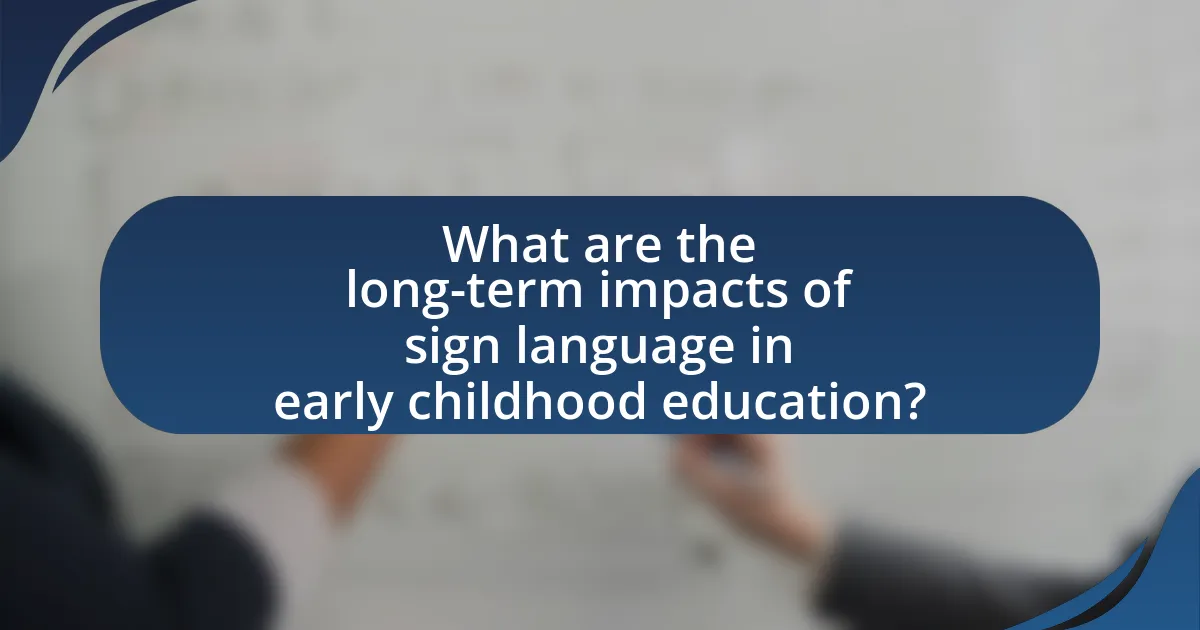
What are the long-term impacts of sign language in early childhood education?
The long-term impacts of sign language in early childhood education include enhanced cognitive development, improved communication skills, and increased social-emotional growth. Research indicates that children exposed to sign language demonstrate better language acquisition and literacy skills, as evidenced by a study published in the Journal of Deaf Studies and Deaf Education, which found that early sign language exposure correlates with higher reading proficiency in later years. Additionally, sign language fosters inclusivity and empathy among peers, promoting social interactions and emotional intelligence, as highlighted in findings from the American Annals of the Deaf. These benefits contribute to a more holistic educational experience, supporting both academic and personal development in children.
How does early exposure to sign language affect later academic success?
Early exposure to sign language positively affects later academic success by enhancing cognitive development and language skills. Research indicates that children who learn sign language early demonstrate improved literacy and communication abilities, as sign language fosters visual-spatial skills and enhances memory. A study published in the Journal of Deaf Studies and Deaf Education found that children exposed to sign language before age three scored higher on reading assessments compared to their peers who did not have such exposure. This correlation suggests that early sign language acquisition supports foundational skills critical for academic achievement.
What evidence supports the benefits of sign language in lifelong learning?
Sign language enhances lifelong learning by improving cognitive skills, communication abilities, and social interactions. Research indicates that children who learn sign language exhibit better memory retention and problem-solving skills compared to their peers who do not use sign language. A study published in the Journal of Deaf Studies and Deaf Education by researchers Susan R. Easterbrooks and Susan A. Baker found that early exposure to sign language positively impacts literacy development and academic achievement in deaf and hearing children alike. Additionally, sign language fosters inclusivity and empathy, which are essential for effective lifelong learning.
What best practices should educators follow when teaching sign language?
Educators should use a multi-sensory approach when teaching sign language, incorporating visual, auditory, and kinesthetic learning styles. This method enhances comprehension and retention, as research indicates that children learn best through engaging multiple senses. Additionally, educators should model signs consistently and encourage students to practice in real-life contexts, which reinforces learning and builds confidence. Using storytelling and interactive activities can also promote engagement and facilitate language acquisition. Studies show that immersive environments, where sign language is used regularly, significantly improve fluency and understanding among learners.
How can educators create an inclusive environment for sign language learners?
Educators can create an inclusive environment for sign language learners by integrating sign language into daily classroom activities and fostering a culture of acceptance and understanding. This approach encourages communication among all students, regardless of their hearing abilities, and promotes social interaction. Research indicates that classrooms that incorporate sign language not only support deaf and hard-of-hearing students but also enhance the learning experience for hearing peers by improving their communication skills and cultural awareness. For instance, a study published in the Journal of Deaf Studies and Deaf Education found that inclusive practices lead to better academic outcomes and social integration for sign language learners.
What tips can help educators maintain engagement in sign language lessons?
To maintain engagement in sign language lessons, educators should incorporate interactive activities that promote active participation. Engaging students through games, storytelling, and role-playing can enhance their learning experience and retention of sign language skills. Research indicates that interactive learning environments significantly improve student engagement and motivation, as evidenced by a study published in the Journal of Educational Psychology, which found that students in interactive settings showed a 30% increase in retention compared to traditional methods. Additionally, using visual aids and incorporating technology, such as videos and apps, can further capture students’ attention and facilitate understanding of sign language concepts.
